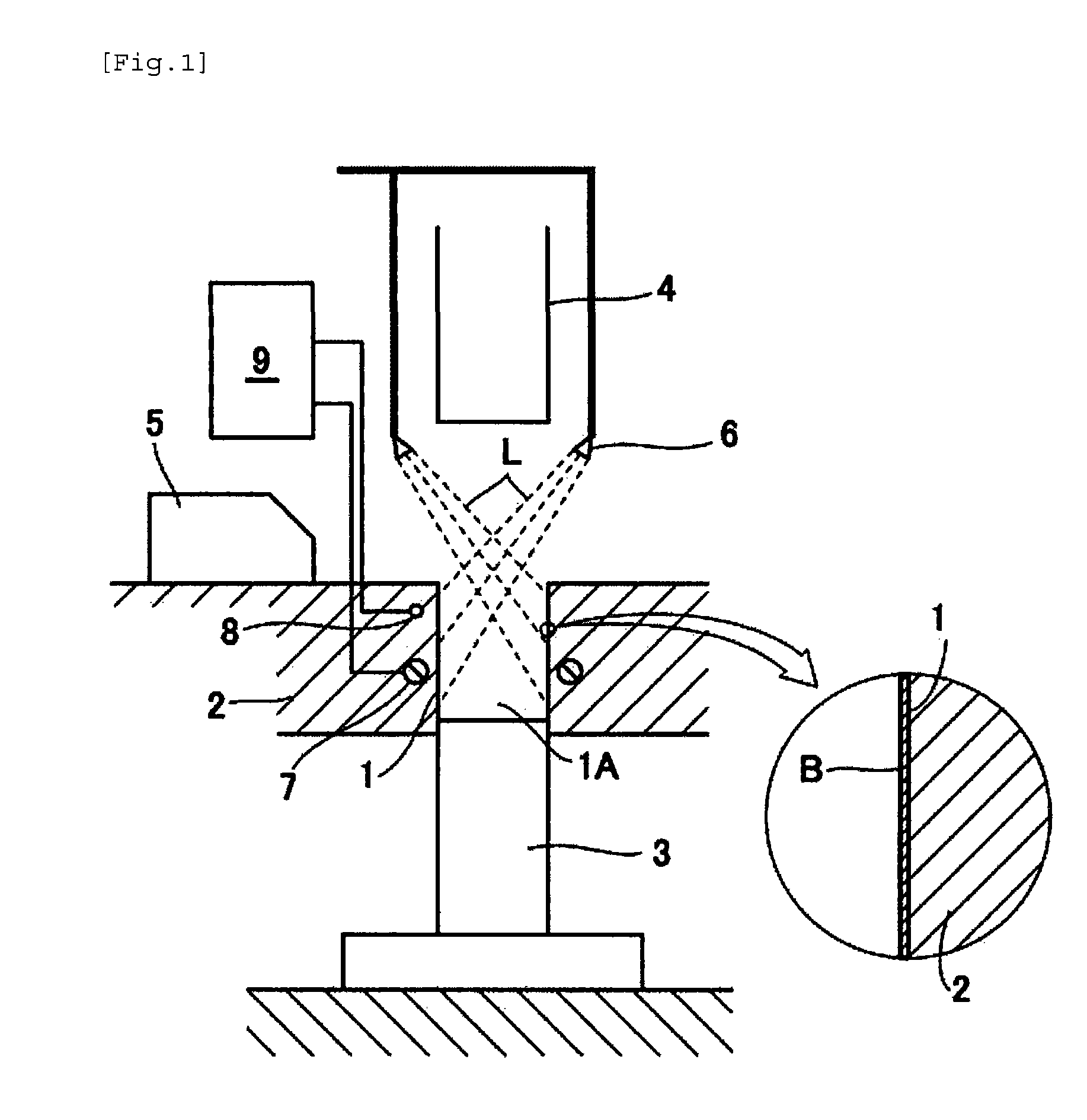Method for Forming Powder Molding Product and Mold Apparatus for Powder Molding
- Summary
- Abstract
- Description
- Claims
- Application Information
AI Technical Summary
Benefits of technology
Problems solved by technology
Method used
Image
Examples
example 1
[0036]Example 1 of the present invention will now be explained with reference to FIGS. 1 to 4. FIG. 1 represents a first process. According to the same Figures, numeral 1 designates a through-hole formed in a die 2 serving as a mold for molding sides of a powder molding product A, i.e., compact as a later-described powder molded body. A lower punch 3 is fitted into the through-hole from the underneath thereof and an upper punch 4 is also fitted into the through-hole 1 from the above thereof. A feeder 5, which provides a raw powder M, is slidably provided on an upper surface of the die 2. Above the through-hole 1 is provided a spray member 6 serving as a solution applying means for spraying a lubricant solution L so as to attach the same to a molding portion 1A of the mold. The spray member 6 is arranged so as to face the through-hole 1, and is connected to a tank of the solution L (not shown) via an automatically openable and closable valve (not shown) . A heater 7 and a temperature...
example 2
[0061]FIG. 5-FIG. 8 represent example 2. in which the same reference symbols as Example 1 will be designated by the same symbols, and their repeated detailed description will be omitted. A surface 10 of the through-hole 1 is formed with a surface treatment layer 11 by hydrophilicity imparting treatment to the surface 10 for improving the wetting action of the aqueous solution L relative to the surface 10, or by arranging hydrophilic material thereon. An angle X of contact of the surface treatment layer 11 relative to the aqueous solution L is smaller than an angle Y of contact of the surface 10, which is made from the material of the die 2 itself, or of the upper surface 2A where the material is exposed, relative to the aqueous solution L (X10 and the upper surface 2A horizontally. And the surface treatment layer 11 is formed by: the thermal spraying, PVD, CVD or shot peening of oxide, fluoride, nitride, chloride, sulfide, bromide, iodide, carbide, hydroxide and etc. having bonds as...
example 3
[0066]FIG. 9 and FIG. 10 represent Example 3, in which the same reference symbols as those in Example 1 and Example 2 will be designated by the same symbols, and their repeated detailed description will be omitted. According to the Example 2, the upper surface 2A of the die 2 on which feed 5 is slidably provided is formed with a surface treatment layer 21 by water repellency imparting treatment to the surface 2A for improving its liquid repelling ability (i.e., reducing the wetting action of the aqueous solution L) relative to the surface 2A, or by arranging water repellent material thereon. An angle Y′ of contact of the surface treatment layer 21 relative to the aqueous solution L is larger than an angle X′ of contact of the surface made from the material of the die 2 itself, or in Example 3 the surface 10 of the through-hole 1, relative to the aqueous solution L (Y′>X′), thus enabling the said wetting action to be reduced. The above surface treatment layer 21 may be formed from si...
PUM
| Property | Measurement | Unit |
|---|---|---|
| Temperature | aaaaa | aaaaa |
| Percent by mass | aaaaa | aaaaa |
| Mass | aaaaa | aaaaa |
Abstract
Description
Claims
Application Information
 Login to View More
Login to View More - R&D
- Intellectual Property
- Life Sciences
- Materials
- Tech Scout
- Unparalleled Data Quality
- Higher Quality Content
- 60% Fewer Hallucinations
Browse by: Latest US Patents, China's latest patents, Technical Efficacy Thesaurus, Application Domain, Technology Topic, Popular Technical Reports.
© 2025 PatSnap. All rights reserved.Legal|Privacy policy|Modern Slavery Act Transparency Statement|Sitemap|About US| Contact US: help@patsnap.com



